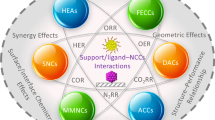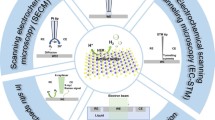Abstract
To give a basic understanding of the experimentally observed difference between Cr2O3 and Al2O3 scales on carbon permeation, we employed the first-principles calculation methods to predict atomistic structures, formation energies, and carbon binding energies of Σ11 \({{\left\{ {10\bar{1}1} \right\}} \mathord{\left/ {\vphantom {{\left\{ {10\bar{1}1} \right\}} {\left\{ {10\bar{1}\bar{1}} \right\}}}} \right. \kern-0pt} {\left\{ {10\bar{1}\bar{1}} \right\}}}\) tilt grain boundaries (GB) in both α-Al2O3 and α-Cr2O3 with a corundum structure. Owing to different surface terminations, we predicted two distinct kinds of stable atomistic structures for the GB: one with measurable voids and high formation energy, and the other with a compact interface and low formation energy. The predicted GB structures agree with experimental images. No significant structural difference was found for the same GB in α-Al2O3 and α-Cr2O3. Moreover, we predicted that atomic carbon would bind to the Σ11 \({{\left\{ {10\bar{1}1} \right\}} \mathord{\left/ {\vphantom {{\left\{ {10\bar{1}1} \right\}} {\left\{ {10\bar{1}\bar{1}} \right\}}}} \right. \kern-0pt} {\left\{ {10\bar{1}\bar{1}} \right\}}}\) GB in α-Cr2O3 appreciably more strongly than in α-Al2O3. Therefore, our computational results suggest that chemical affinity rather than geometric structure of the GBs is related to different carbon permeation behaviors in Al2O3 and Cr2O3 scales.
Graphic Abstract







Similar content being viewed by others
References
J. H. Perepezko, Science326, 2009 (1068).
D. J. Young and J. Zhang, JOM70, 2018 (1493).
M. P. Brady, I. G. Wright and B. Gleeson, JOM52, 2000 (16).
N. P. Padture, M. Gell and E. H. Jordan, Science Science (New York, N.Y.)296, 2002 (280). https://doi.org/10.1126/science.1068609.
R. Prescott and M. J. Graham, Oxidation of Metals38, 1992 (233). https://doi.org/10.1007/bf00666913.
G. H. Meier, et al., Oxidation of Metals74, 2010 (319). https://doi.org/10.1007/s11085-010-9215-5.
N. Otsuka, Y. Shida and H. Fujikawa, Oxidation of Metals32, 1989 (13).
J. Pirón Abellán, T. Olszewski, H. J. Penkalla, G. H. Meier, L. Singheiser and W. J. Quadakkers, Materials at High Temperatures26, 2009 (63).
T. D. Nguyen, J. Q. Zhang and D. J. Young, Materials at High Temperatures32, 2015 (16). https://doi.org/10.1179/0960340914Z.00000000056.
M. H. S. Bidabadi, et al., Corrosion Science 2019. https://doi.org/10.1016/j.corsci.2019.108252.
H. J. Grabke, K. Ohla, J. Peters and I. Wolf, Materials and Corrosion34, 1983 (495). https://doi.org/10.1002/maco.19830341002.
H. M. Tawancy and N. M. Abbas, Journal of Materials Science27, (4), 1992 (1061). https://doi.org/10.1007/bf01197661.
H. M. Tawancy, Oxidation of Metals83, 2015 (167). https://doi.org/10.1007/s11085-014-9513-4.
S. B. Newcomb and W. M. Stobbs, Oxidation of metals26, 1986 (431).
K. Kaya, S. Hayashi and S. Ukai, ISIJ international54, 2014 (1379).
F. Rouillard and T. Furukawa, Corrosion Science105, 2016 (120).
F. Rouillard, G. Moine, L. Martinelli and J. Ruiz, Oxidation of Metals77, 2012 (27).
T. Gheno, D. Monceau and D. J. Young, Corrosion Science64, 2012 (222).
C. S. Giggins and F. S. Pettit, Oxidation of Metals14, 1980 (363). https://doi.org/10.1007/bf00603609.
C. Fujii and R. Meussner, Journal of the Electrochemical Society114, 1967 (435).
I. Wolf and H. J. Grabke, Solid State Communications54, 1985 (5). https://doi.org/10.1016/0038-1098(85)91021-X.
D. J. Young, T. D. Nguyen, P. Felfer, J. Zhang and J. M. Cairney, Scripta Materialia77, 2014 (29).
T. D. Nguyen, A. La Fontaine, L. Yang, J. M. Cairney, J. Zhang and D. J. Young, Corrosion Science132, 2018 (125). https://doi.org/10.1016/j.corsci.2017.12.024.
J. Cho, H. Chan, M. Harmer and J. Rickman, Journal of the American Ceramic Society81, 2005 (3001). https://doi.org/10.1111/j.1151-2916.1998.tb02726.x.
T. Nakagawa, et al., Acta Materialia55, 2007 (6627).
Y. Lei, Y. Gong, Z. Duan and G. Wang, Physical Review B87, 2013 (214105). https://doi.org/10.1103/PhysRevB.87.214105.
T. Höche, P. R. Kenway, H.-J. Kleebe, M. Rühle and P. A. Morris, Journal of the American Ceramic Society77, 1994 (339). https://doi.org/10.1111/j.1151-2916.1994.tb07001.x.
P. R. Kenway, Journal of the American Ceramic Society77, 1994 (349). https://doi.org/10.1111/j.1151-2916.1994.tb07002.x.
T. Höche, P. R. Kenway, H.-J. Kleebe, M. W. Finnis and M. Rühle, Journal of Physics and Chemistry of Solids55, 1994 (1067). https://doi.org/10.1016/0022-3697(94)90125-2.
S.-D. Mo, W.-Y. Ching and R. H. French, Journal of the American Ceramic Society79, 1996 (627). https://doi.org/10.1111/j.1151-2916.1996.tb07921.x.
G. Kresse, Journal of Non-Crystalline Solids192–193, 1995 (222). https://doi.org/10.1016/0022-3093(95)00355-X.
G. Kresse and J. Furthmüller, Computational Materials Science6, 1996 (15). https://doi.org/10.1016/0927-0256(96)00008-0.
G. Kresse and D. Joubert, Physical Review B59, 1999 (1758). https://doi.org/10.1103/PhysRevB.59.1758.
J. P. Perdew, K. Burke and M. Ernzerhof, Physical review letters77, 1996 (3865).
A. I. Liechtenstein, V. V. Anisimov and J. Zaanen, Physical Review. B, Condensed Matter52, 1995 (R5467). https://doi.org/10.1103/physrevb.52.r5467.
Y. Wang, et al., Surface Science606, 2012 (1422). https://doi.org/10.1016/j.susc.2012.05.006.
C. Gray, Y. Lei and G. Wang, Journal of Applied Physics120, 2016 (215101). https://doi.org/10.1063/1.4970882.
J. C. Boettger, Physical Review B55, 1997 (750).
F. O. Lebreau, M. M. Islam, B. Diawara and P. Marcus, The Journal of Physical Chemistry C118, 2014 (18133).
H. d’Amour, D. Schiferl, W. Denner, H. Schulz and W. B. Holzapfel, Journal of Applied Physics49, 1978 (4411).
L. W. Finger and R. M. Hazen, Journal of Applied Physics51, 1980 (5362).
I. Milas, B. Hinnemann and A. E. Carter, Journal of Materials Research23, 2008 (22). https://doi.org/10.1557/jmr.2008.0188.
Acknowledgements
This work was supported by the Tsinghua University Initiative Scientific Research Program and the National Magnetic Confinement Fusion Energy Research Project of China (2015GB118001). Y. Zheng thanks the CSC for the financial support (201706210110) to visit University of Pittsburgh. G. Wang gratefully acknowledges computational resources provided by the University of Pittsburgh Center for Research Computing.
Author information
Authors and Affiliations
Corresponding authors
Additional information
Publisher's Note
Springer Nature remains neutral with regard to jurisdictional claims in published maps and institutional affiliations.
Rights and permissions
About this article
Cite this article
Zheng, Y., Liu, Z., Lei, Y. et al. First-Principles Calculated Structures and Carbon Binding Energies of Σ11 \({{\left\{ {10\bar{1}1} \right\}} \mathord{\left/ {\vphantom {{\left\{ {10\bar{1}1} \right\}} {\left\{ {10\bar{1}\bar{1}} \right\}}}} \right. \kern-0pt} {\left\{ {10\bar{1}\bar{1}} \right\}}}\) Tilt Grain Boundaries in Corundum Structured Metal Oxides. Oxid Met 94, 37–49 (2020). https://doi.org/10.1007/s11085-020-09977-4
Received:
Revised:
Published:
Issue Date:
DOI: https://doi.org/10.1007/s11085-020-09977-4




